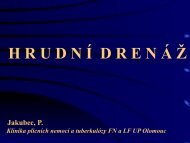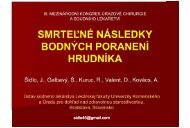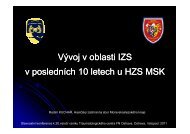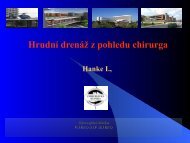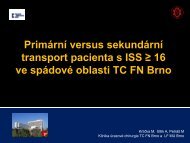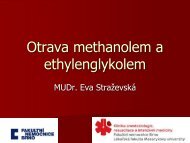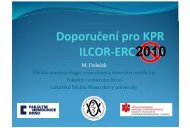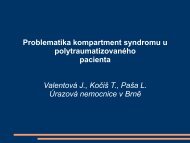Felipe Munera, MD Professor of Radiology ... - AKUTNE.CZ
Felipe Munera, MD Professor of Radiology ... - AKUTNE.CZ
Felipe Munera, MD Professor of Radiology ... - AKUTNE.CZ
- No tags were found...
You also want an ePaper? Increase the reach of your titles
YUMPU automatically turns print PDFs into web optimized ePapers that Google loves.
Ryder Trauma Center<strong>Felipe</strong> <strong>Munera</strong>, <strong>MD</strong><strong>Pr<strong>of</strong>essor</strong> <strong>of</strong> <strong>Radiology</strong> - University <strong>of</strong> Miami MillerSchool <strong>of</strong> Medicine Jackson Memorial Hospital
Learning Objectives1. Discuss indications <strong>of</strong> the whole Body<strong>MD</strong>CT2. Describe whole body CT protocolscurrently in use3. Review key injuries identified withWBCTA that require urgent interventionD. Dreizin and F. <strong>Munera</strong>. Radiographics 2012; 32: 609-631
Trauma Epidemiology• Trauma is the leading cause <strong>of</strong> death < 45• In trauma, “time is life”. Outcomes greatlyimproved when critical interventions are providedwithin the golden hour following injury.• WB<strong>MD</strong>CT can decrease the LOS ¹ in the traumaroom and increase survival ²1 - Hilbert P, et al Injury 2007; 38(5): 552-558- Wurmb TE, et al JOT 2009;66(3):658-65 & E Med J. 2011; 28(4):300-4- Tso D, et al RSNA’112. Huber-Wagner S, et al Lancet 2009; 373: 1455-61.
Role <strong>of</strong> <strong>MD</strong>CT in polytraumaHelp Guide management!• Goals:1. Determine who has significantinjuries2. Who needs surgical or endovascularintervention?
CT findings in polytrauma requiringsurgical or percutaneousintervention:1. Major vascular injuries2. Active Hemorrhage3. Unstable spinal fractures4. Diaphragmatic rupture5. Pancreatic injury with ductal involvement6. Injuries <strong>of</strong> the mesentery or hollow viscera
1. Indications-When WB<strong>MD</strong>CT?• High-velocity mechanism <strong>of</strong> injury• High-speed MVA or falls from heights > 3m, Pedestrians HBC• Ejection from vehicle, severe car deformity,knowledge about fatalities, etc
2. Trauma Whole Body CTTechniques• Segmented Whole body CT scan:• CTA Chest• Portal Phase Abdomen and Pelvis.• Single pass whole body CT:WBCTA• Single pass through the neck, chest,abdomen and pelvis.D. Dreizin and F. <strong>Munera</strong>. Radiographics 31:609-31 2012F. <strong>Munera</strong>, Rivas LA, et al. <strong>Radiology</strong> 263:645-60 2012
RICA + AoDiaphragmaticInjuries
“Whole Body” CT AngiogramUMiami protocol severe blunt polytrauma• Unenhanced CT <strong>of</strong> the brain• Circle <strong>of</strong> Willis to symphysis pubis• Delay: empiric 20 seconds (25 s > 55 y/o)• No oral contrast• Automated exposure control (reference MA 200)• <strong>MD</strong>CT (64 or 128): 0.6 mm, 3.0 & 1.5 mm• Routine sagital and coronal reformations & 3Dreconstructions generated at PACS workstation
2. WB <strong>MD</strong>CT Technique:ControversiesArm Positioning? above head, along body,flexed over the chest, “swimmers” etc.• “ How we do it ”: Arms up(unless prevented by fractureor injury) – ↓ dose* Brink etal. <strong>Radiology</strong>’10• Karlo CA, et al. Emerg Radiol 18: 285–293 2011• Lemos A, et al ECR’11
2. WBCTechnique: Controversies• Ideal injection protocol?• single bolus 400 mg/ml: Nguyen et al AJR’09biphasic, triphasic: Loupatatzis et al Eur Radiol’08, S. Bader RSNA’11, split bolus Clark T et al,Glaser-Gallion et al RSNA’11, dual bolus FranklinRSNA’12, Biphasic injection: > uniform/prolongenhancement*“ How we do it”: 100 mL 350 mg/mL Biphasic: @ 4 mL/s15 sec, then 3 mL/s followed by 40 mL saline chaser @ 4mL/s* Bae KT. <strong>Radiology</strong>. 2010;256(1):32-61.
Portal PhaseRoutine Portal PhaseExtensive laceration +venous involvement: ↑riskconcomitant arterial injuryArterial
Portal: second point in timeArterialPortalActive extravasation
SelectiveAcquisitionDelayedimages• Hemoperitoneum• Free fluid• Vascular lesion• Renal injury• Mesenterichematoma• Pelvic fracturesArterialdelay
Image Interpretation• Be Mindful <strong>of</strong> known associations
AP Compression mechanism:Midline force vectorTeaching point:Because <strong>of</strong> the largevolume <strong>of</strong>information at wholebody CT, efficientsearch requiresdetermining injurymechanism & forcevector.Intervention: distalpancreatectomy28 yo female restrained driver ina mva who collided with a parkedcar at high speed
Image Interpretation
3a. Continuous Acquisition:Integration <strong>of</strong> Neck Indication for C-spine imaging + contrastenhanced body CT Neck routinely included with contrast Sliker, et al AJR’08 No significant differencesbetween dedicated neck <strong>MD</strong>CTA and wholebody-<strong>MD</strong>CT as part <strong>of</strong> a routine traumaprotocol ** Sliker CW, Shanmuganathan K, Mirvis SE AJR 2008; 190:790-9• Chokshi FH, <strong>Munera</strong> F, Rivas LA, et al AJR. 2011;196 (3):W309-15• <strong>Munera</strong> F, Foley M, Chokshi FH. RCNA 2012; 50 (1): 59-72
RVA Blunt Injury•C4-C5 facet fracture-Subluxation
3. WB<strong>MD</strong>CTIntegration <strong>of</strong>Lower extremities• Selectively in patients withclinical suspicion <strong>of</strong> arterialinjuries• Results in diagnosticimage quality in themajority <strong>of</strong> patients ** Foster BR, Anderson SW, Uyeda JW, et al. <strong>Radiology</strong> 2011; 261:787–795
4. WBCTAIntegration<strong>of</strong> Lowerextremities
4a. WBCTA in Solid OrganInjuries• Controversies:• Optimal timing for evaluation <strong>of</strong> solidorgans?• CTA improves visualization <strong>of</strong> VascularInjury on late arterial phase• Is an additional phase needed todetermine, clarify or exclude injury?Portal? Delayed?•Boskak AR et al, K Shan, Mirvis SE, et al RSNA’11•Uyeda, J et al ASER 11• Foley M, <strong>Munera</strong> F, Rivas LA, et al RSNA’10• Lemos A, et al RSNA’08 and Franklin RSNA’12
Case # 1s/p MVACase # 2PortalLate ArterialPhaseVacularInjury?Portal PhaseArterial
4a. WBCTA in Solid Organ InjuriesPancreatic InjuriesEarly deaths usually dueto acute hemorrhagefrom major vascular injurPancreatic injuries that requireintervention involve the pancreaticduct• Deep pancreatic lacerations >50% pancreatic thickness:suspicion for PD disruptionWarrant additional imaging(MRCP or ERCP) *.PancreaticnecktransectionIntervention: Curve MPR distalpancreatectomy* Gupta A, et al RadioGraphics 2008; 24: 1381-1395* Linsenmaier U. RadioGraphics 2008; 28:1591–1601
4b. WBCTA in Osseous InjuriesL2All bony & vascularstructures from COW toSP are evaluated,including cervical,thoracic, LS spine &pelvisPelvic Extravasation
4c. WBCTAin VascularInjuriesAorticPseudoaneurysm
Typical4c. WBCTA in Vascular Injuries
4d. WBCTA injuries <strong>of</strong> theMesentery or hollow viscera• Focal jejunal wall defect• Free air
5. Pitfalls – False PositivesPotentialcauses <strong>of</strong> falsepositives onCTA include:1.Interval thrombosis <strong>of</strong> vessel2.Venous hemorrhageInterval thrombosis <strong>of</strong> the artery feedingthe pseudoaneurysm
Pitfalls: Diaphragmatic Injuries“Band““Hump”7daysBeware <strong>of</strong> RHD injuries!
WB <strong>MD</strong>CT- The price to pay• 1. Data explosion:• Remove unnecessary series (bone, lungalgorithm recons)• 2. Excessive radiation:• Avoid unnecessary studies• Automated exposure control/ iterativerecons• Low dose for extremities CTA, arterialand delayed images• We need to get use to noisy images
Summary WB CTA ProtocolNeck/Chest/APAbdomenAorta:12 secLiver:60-70 sec20”70”0 t2’100 mL @ 4 mL/s 15 sec, then 3 mL/s
Conclusion1. No universally accepted standard protocol2. WBCTA identifies blunt polytrauma relatedinjuries which require intervention3. Consider possible pitfalls: impropertechnique, false + CTAs, Nl variants, andartifacts4. Indiscriminate use <strong>of</strong> Whole Body CT forpatients with minor injuries is not justified
Thank you foryour attention!fmunera@med.miami.edu



